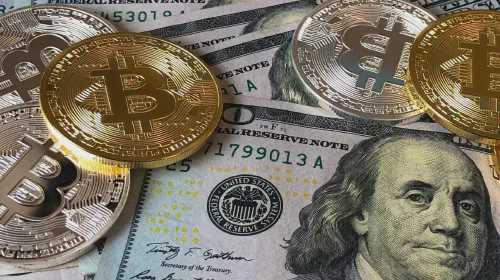Fiat-Collateralized Stablecoins: Definition, Use Cases, and Stability
Salomon Kisters
Aug 15, 2022This post may contain affiliate links. If you use these links to buy something we may earn a commission. Thanks!
As blockchain technology evolves, developers and service providers have enabled a range of services to internet users. Many types of crypto coins in the market have been issued as a result, which reflects the diverse nature of the technology and its interconnected digital economy.
Cryptocurrencies have been the driving force behind many digital innovations used in financial payments, technical utility, security, and digital currency exchanges. Coins that are used specifically for trading cryptocurrencies for fiat currency or other crypto coins are called stablecoins. Stablecoins have become very popular in recent times. In fact, the market cap for the top 10 stablecoins has increased over 25 times the value since 2020.
We can classify stablecoins further into different categories, although in this article, we will focus on fiat-collateralized stablecoins. Before we dive into the details of these stablecoins, let’s refresh your knowledge about stablecoins.
What are Stablecoins?
As the name suggests, stablecoins are cryptocurrency coins that are pegged to a specific currency or asset. The main feature that distinguishes stablecoins from other types of cryptocurrencies is that their value is relatively stable. Stablecoins are usually not prone to the price volatility seen in conventional cryptocurrencies like BTC and ETH, as the stability is incorporated into the digital currency itself.
Stablecoins are used in centralized (CEX) and decentralized DEX cryptocurrency exchanges as they allow the trading of different assets without the risk of large price swings otherwise seen in currency markets. This is because they work like reserve currencies and can be issued or withdrawn from the market in response to demand and supply fluctuations.
Types of Stablecoins
Stablecoins are classified based on the asset or method used to stabilize them. The various types of stablecoins are:
- Fiat-collateralized: These are pegged to a fiat currency, usually USD.
- Crypto-collateralized: These are pegged to a specific cryptocurrency.
- Commodity-collateralized: These are backed by physical assets (metals, raw materials, real estate).
- Algorithmic: These are backed by computer programs that work as smart contracts in DeFI apps.
Benefits of Stablecoins
Low Risk
The value of stablecoins does not fluctuate by extreme margins. Therefore, anyone holding on to stablecoins or using them for trading can do so without having to worry about their asset portfolio losing significant value.
Liquidity Management
The parity with fiat currencies means that stablecoins can be used to quickly withdraw funds when required. This is an important use case for managing a business or personal finances. Conversely, they can also be used by exchanges to inject liquidity into the market by drawing from fiat currency reserves.
Reliable Medium of Exchange
Stablecoins are used to power many exchanges and applications as they bridge the gap between different currencies. They can be used for connecting different blockchain ecosystems together to facilitate payments or utility.
Increasing User Participation in the Blockchain Ecosystem
By allowing a risk-free exchange of assets and connecting a range of DeFI applications and services, stablecoins reduce barriers for users around the world to buying and selling cryptocurrencies and using blockchain-enabled services.
Fiat-collateralized Stablecoins
This class of stablecoins is the most well-known. As we mentioned above, the fiat currency of choice in fiat-collateralized stablecoins is usually USD, which is a strong currency and has global acceptance in financial and consumer markets.
Therefore, we can think of fiat-collateralized stablecoins as the crypto representation of the USD within the digital space. For investors, they represent a reserve of crypto coins that can be used as liquid assets without having to be stored in cash.
The peg is usually a 1:1 ratio. For example, 1 Gemini USD stablecoin (GUSD) will be equal to 1 USD. In most cases, the peg is soft, meaning that as the supply of USD goes up or down, it will affect the value of the stablecoin in the same way.
How do Fiat-collateralized Stablecoins Remain Stable?
One way an issuer of a fiat collateralized stablecoin controls its price is by backing the currency with a reserve amount of fiat currency in their bank account. The amount of reserves in this account needs to be able to pay for the number of stablecoins in circulation.
For example, if there are reserves of $1,000 in the reserve account, then the number of stablecoins distributed in the market should be equal to 1,000, assuming a 1:1 peg to the USD. Our example is a simple one, as in reality, reserve accounts require millions or billions of USD since stablecoins are issued in large quantities.
The fiat currency reserves are also called off-chain reserves as they do not exist in the blockchain itself. To manage such types of asset holdings, some companies like Gemini (which is the issuer of GUSD) require customers to complete KYC forms to minimize fraud risk.
In many cases, the fiat currency reserves are kept by financial institutions that act as trusts. Depending on the company, investors may request the reserves to be audited. The role of independent custodians and auditing committees is important as it incentivizes fund managers to work for the benefit of investors and keep the currency peg operational.
Problems with Fiat-collateralized Stablecoins
Despite the popularity and security that fiat-collateralized stablecoins provide to cryptocurrency investors, they are not without problems. It’s important to understand that, like all other cryptocurrencies, there is still some risk tied to their use.
Loss of the 1:1 Peg
Many factors can result in the value of a stablecoin significantly diverging from the 1:1 parity with its fiat currency and usually in the negative. The most famous case of this happening is that of TerraUSD (UST) in May 2022, which collapsed from its 1:1 peg to a value of 10 cents within a week.
The crash was attributed to mass withdrawals from its blockchain protocols along with an overall decline in bitcoin value, which also resulted in lower investor confidence. UST’s crash had a ripple effect across the crypto world, with Tether going as low as 95 cents in the same month.
In June, Tether’s USDT again lost its peg from the USD after a major cryptocurrency lender halted withdrawals for account holders.
Therefore, fiat-backed stablecoins can be influenced by market sentiments in situations where crypto markets experience a major crash. Investors lose confidence at these times, prompting a change in value.
Legality
Stablecoins are not recognized as legal tender in many jurisdictions. That means their value is restricted to the exchanges that utilize them. Any restriction of access or use of crypto assets can prevent you from withdrawing cash if the need arises.
We advise all crypto users to consider these risks before using any type of cryptocurrency, including those backed by fiat currencies.
Lack of transparency
Because fiat-collateralized stablecoins require currency reserves for backing, investors usually request independent audits to ensure that they are effectively managed. However, organizations like iFinex and Tether have come under scrutiny for being unable to prove that their stablecoins are backed by USD reserves.
Mismanagement and accounting lapses are major drivers of risk for any investor, and a negative perception of a company can tank its stablecoin value.
Cybersecurity risks
Blockchains are vulnerable to hacks. A successful hack basically renders the entire blockchain susceptible to subsequent attacks and requires a hard fork to issue new tokens. As a result, any stablecoins on the previous blockchain are untradeable. In other words, the fiat collateral would be meaningless.
Cybersecurity risks like these also prompt companies to temporarily halt operations that can prevent withdrawals. Fortunately, blockchains are difficult to hack by traditional means and are a rare occurrence.
Notable Fiat-collateralized Stablecoins
Our blog would be incomplete without a mention of some popular fiat-collateralized stablecoins. Here are some notable ones.
Gemini Dollar (GUSD)
- GUSD is issued by Gemini, a US-based crypto exchange.
- It is the first regulated stablecoin with the Ethereum blockchain using the ERC20 standard.
- GUSD is pegged 1:1 to the USD.
- It is backed by funds held by State Street Bank.
- It is audited by BPM.
Pax Dollar (USDP)
- USDP is Issued by Paxos, a US-based crypto exchange.
- It operates on the Ethereum blockchain as an ERC-20 token.
- USDP is pegged 1:1 to the USD.
- It is a US-audited and regulated stablecoin collateralized by USD.
- It can be used as a utility token.
USD Coin (USDC)
- USDC is issued by Circle and Coinbase.
- It can operate on multiple blockchains including Solana, Ethereum, and Flow.
- USDC is pegged 1:1 to the USD.
- It is governed by a membership-based consortium called Center.
- Its assets are stabilized through smart contracts.
Tether (USDT, EURT, GBPT)
- USDT is issued by Tether, a Hong-Kong-based cryptocurrency organization.
- Issued in 2014, Tether is the world’s first fiat-collateralized stablecoin.
- USDT is pegged 1:1 to the USD; its sister currencies EURT and GBP are similarly pegged to the Euro and Pound Sterling, respectively.
- Tether has achieved widespread adoption due to its first-mover advantage in the stablecoin space.
Binance USD (BUSD)
- BUSD is issued by Binance (a multinational crypto exchange) in partnership with Paxos Trust (which holds the fiat collateral).
- It is used to trade cryptos and withdraw fiat currency from Binance.
- BUSD is pegged 1:1 to the USD.
- It can be used to buy other stablecoins with zero transaction fees.
The Bottom Line
Stablecoins backed by fiat currencies have significantly transformed the cryptocurrency market. Internet users have many options for investing and trading their available funds. We hope our guide gives you a good idea of the ins and outs of fiat collateralized stablecoins.
If you are interested in learning more you can visit CryptoRunners guide about stablecoins. Note that the article is in Swedish and can be translated from goog
Stay informed with the latest insights in Crypto, Blockchain, and Cyber-Security! Subscribe to our newsletter now to receive exclusive updates, expert analyses, and current developments directly to your inbox. Don't miss the opportunity to expand your knowledge and stay up-to-date.
Love what you're reading? Subscribe for top stories in Crypto, Blockchain, and Cyber-Security. Stay informed with exclusive updates.
Please note that the Content may have been generated with the Help of AI. The editorial content of OriginStamp AG does not constitute a recommendation for investment or purchase advice. In principle, an investment can also lead to a total loss. Therefore, please seek advice before making an investment decision.

What Are Algorithmic Stablecoins?
Algorithmic stablecoins are backed by an on-chain protocol that pegs their value to a supply/demand ratio maintained by an algorithm. Let's have a closer look.

What Is Binance and What Is It Used For?
If you're new to the crypto market and wondering what Binance is, you're not alone. In this article, we'll have a detailed look.

What Is Cardano and What Is It Used for?
If you have been in the crypto space even for a little while, chances are you have come across the name "Cardano" multiple times. But what is Cardano exactly?
Protect your documents
Your gateway to unforgeable data. Imprint the authenticity of your information with our blockchain timestamp